Many of my friends and family keep chickens so I’ve seen lots of chicken coops and runs throughout Southern California. Every set up I’ve seen with a floor of wood chips is better than those I’ve seen without, with very few exceptions.
Consider keeping your chickens on a deep layer of wood chips or a similar bed of plant materials. Here is how and why.
(What are wood chips?)

Health
The first reason is to soak up the manure. Chickens pee and poop at the same time, they do so throughout the day, and they do so throughout the night while they’re sleeping. It adds up fast.
If it’s not cleaned up fast, it stinks to high heaven. That’s no fun for us when we visit the birds, but think about them. They breathe that toxic air 24/7. The harsh ammonia gas injures their respiratory pathway tissues, reduces their growth, makes them susceptible to diseases, makes them less productive at laying eggs, damages their eyes, and all sorts of other nasty things. (See this paper and this paper for more on the effects of ammonia on chickens.)
So primarily it is for the health of the chickens that I keep a thick layer of wood chips on the floor of my coop and run. My rule is that I should be able to stand right inside and close my eyes and not even know there are chickens around because I can’t smell anything unpleasant. The wood chips, if kept thick enough, accomplish that.
I apply the chips at about a foot in depth at first and then later add some as they decompose in order to keep the layer at least six inches deep.
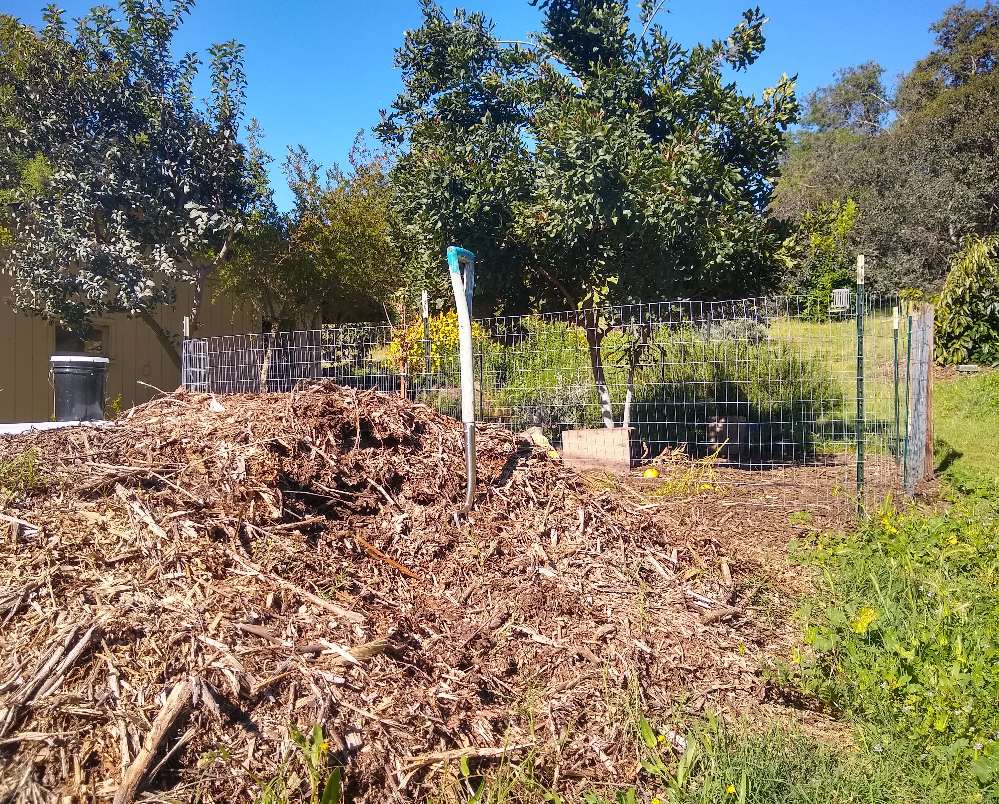
Food
This aspect of the floor of wood chips is mysterious to me, yet it is undeniable that when chickens live on such a floor it begins to create food for them.
I’ve noticed that after a certain amount of time on the wood chips, I need to feed the birds less. For example, today my chickens have been living on a deep bed of wood chips in a new yard area that I created about a year ago (May 2023). At first, I needed to feed them a normal amount of “complete ration” of layer crumble, just as if they lived in a sterile chicken house. Around four months later, I noticed that they weren’t eating as much of the layer crumble as before. Around eight months later, I stopped buying bags of feed at all. Here, a year later, I give them zero such feed.
For months, I have been giving them only the usual kitchen and garden scraps, plus some sunflower seeds and wheat berries, and they look as healthy and act as happy as ever, and they are laying as many quality eggs as ever.

But how? I see them pecking and finding things to eat within the wood chips. I can’t always see what it is they’re finding, but the evidence says it satisfies them.
I came upon some studies from the 1940s and 1950s on chickens raised over similar “deep, old litter” that found similar results. One from 1949 by Kennard and Chamberlin done in Ohio found that chickens raised on a deep, old (at least six months old) litter bed could be fed less and still grow as well or better compared to chickens raised on a new bed and given a complete ration. (See Table 8 on page 14 in “The Use of Compost (Built-up) Litter in Chicken Houses.”)

Compost
The bed of wood chips decomposes with the help of the chickens’ manure and scratching until it can eventually be considered compost. This might take a few months, maybe a year, depending on the wood chips you begin with and the number of chickens and size of the area.
This resulting compost can be harvested and used in your vegetable garden, around fruit trees, as potting mix. I do all three with my chicken compost.

This chicken compost has a couple advantages over pure chicken manure. First, it’s a more versatile product. You can’t grow vegetable seeds in pure chicken manure, but you sure can in chicken compost.
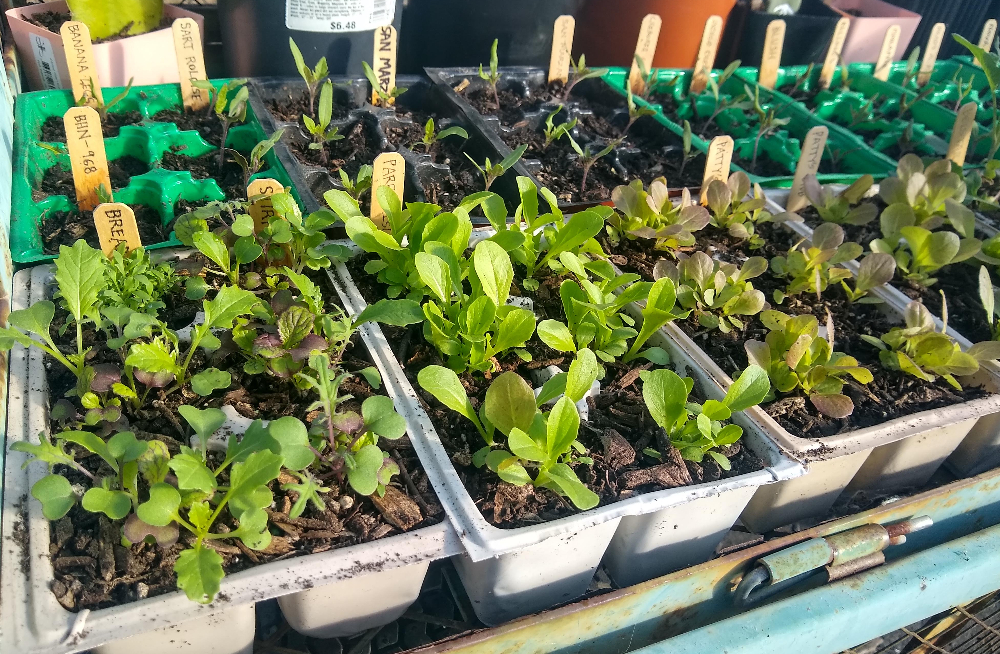
Second, harvesting the compost takes less labor. Without wood chips, the manure must be cleaned out almost daily in order to prevent an unhealthy environment for the birds. With wood chips, you might have a chore once a week at most. From time to time you add more wood chips and you fork an area that is capped, and then you might harvest compost a few times each year.
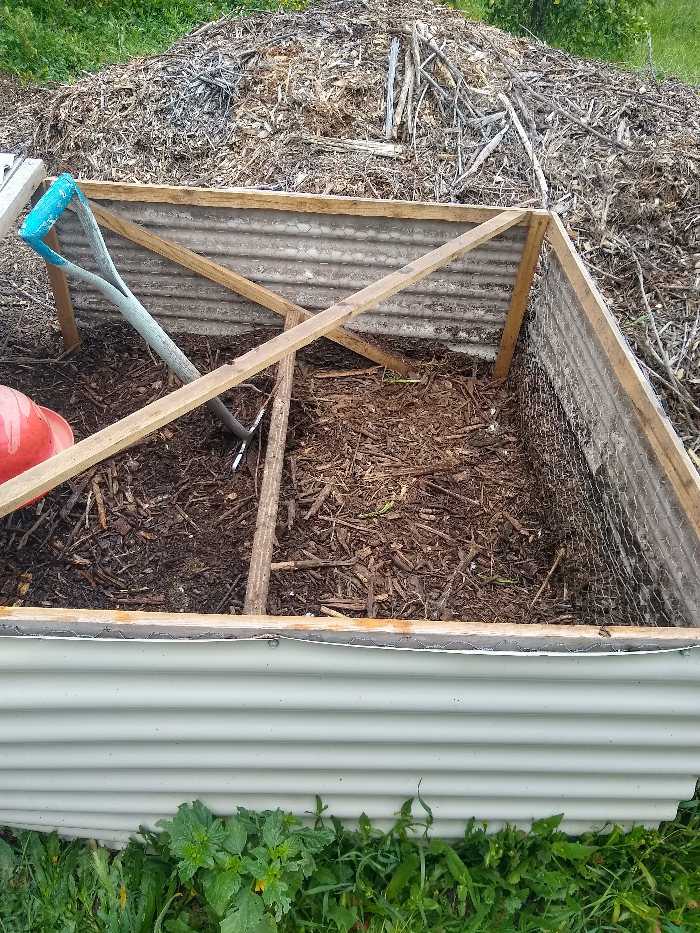
Chicken health, reduction of feed costs, and gaining compost are the three main reasons that I have kept my chickens on a deep bed of wood chips for the past eight years, and many others have found the same benefits, and you might too. Unless you have one of these exceptional situations.
Exceptions
Mobile pen: I have kept chickens in a mobile pen and moved them daily so their floor is ever-new pasture. In Southern California, this is most practical during the winter and spring.
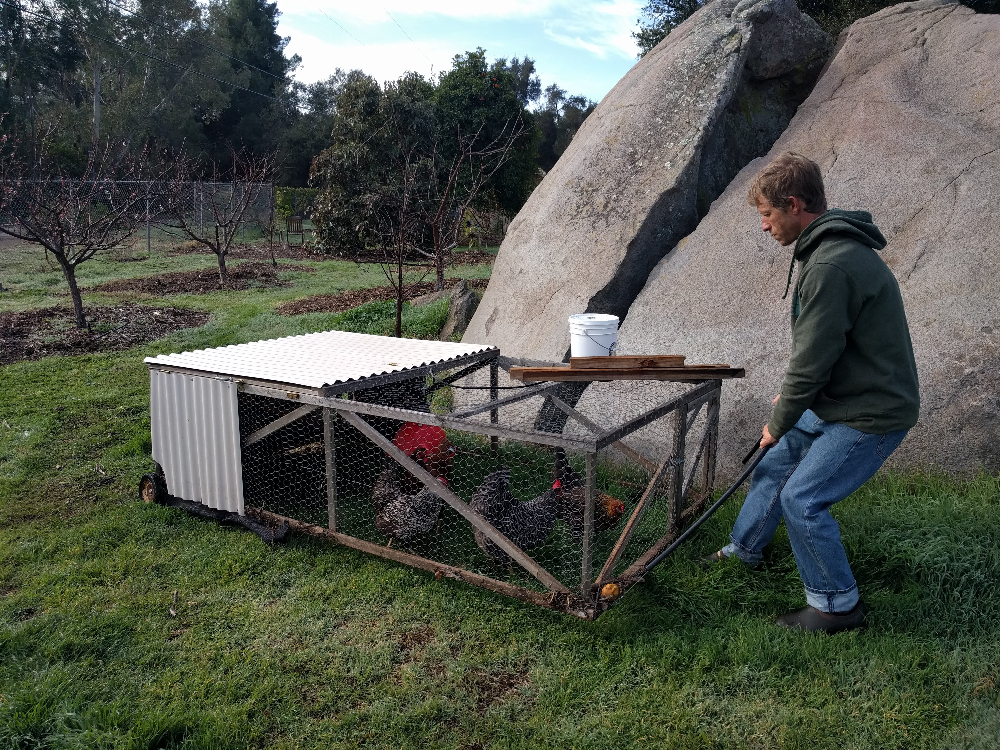
Massive run/yard: I have friends with a large flock but also with a very large pasture area for the flock to forage in. If the number of birds is small enough compared to the run area, then the chickens will not denude it and all will be well.

But the run area must be massive (bigger than most people think is big enough) or else it soon turns into bare ground because the chickens eat almost every plant, and then the ground becomes toxic with their manure.
In all other cases that I have seen, a deep floor of wood chips is the way to go.
Resources
I was first clued in to using a deep bed of wood chips for my chickens by Joel Salatin in his classic book, Pastured Poultry Profits. (See page 260 if you have a copy. And if you raise chickens, you must have a copy.)
Harvey Ussery also has a good chapter (7) on his experience using “deep litter” in his excellent book, The Small-Scale Poultry Flock.
Thanks for your support so I can keep these Yard Posts coming and ad-free.
All of my Yard Posts are listed HERE.

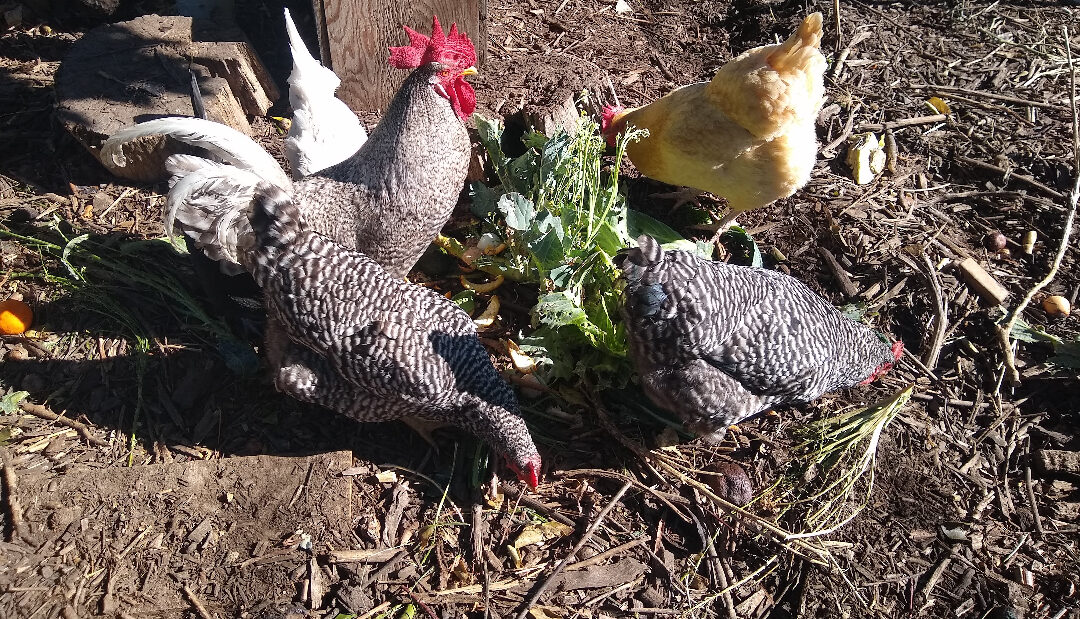


Hi Greg,
I’ve been doing this for years and you are 100% correct. I first learned this technique from Joel Salatin‘s books. I think he calls it deep pack or something similar. I start with a thick layer of woodchips. When things get messy I just add more woodchips. They also get all our kitchen scraps and yard waste. Basically my chicken coop is my compost pile, except I don’t have to turn my compost pile because the chickens do it for me. I clean it out twice a year and use it to mulch the garden. The areas of my yard that have received this mulch show a rapid and long lasting improvement in the health and productivity of those plants. Eggs, healthier chickens, a self turning compost pile, and healthier plants – it’s a win all the way around.
Thanks for this, Joe! I also first learned of this technique from Joel Salatin along with Harvey Ussery. I’ll add that to the post above.
I’ve tried wood shavings in the past. When they accumulate poop, & get wet, they’re a solid mass of wet, & stink. I’ve changed to sand in their house, which dries the poop quickly, reducing the chance of moisture build-up & resultant frostbite. I have flat panel (no exposed coils) heaters for severe temperaures, as the sand doesn’t generate heat. I rake the sand into a pile & sieve the dry poop for composting.
In the run, which is covered on top only by wire, flagstones, so I can easily pick up poop for composting.
They have the run of the yard during the day, so plenty of bug time, & feet off hard surfaces time.
I’m in the city, with only 6 hens, so this may not work for large flocks, but a sifter can be made from a digging fork or hay fork by adding hardware cloth. (I use a small rake, large kitty litter scoop, & dollar store colander to sift. I use only about 3/4″ sand, max, so there’s not too much bulk to sift. My coop is clean in just a few minutes, & no shavings for parasies propagation. Keeping my coop poop, smell, & fly free works for us (and our neighbors!)
Thanks Greg! Insect larvae, other “shredder” organisms and worms, etc., feeding in the wood chip, decomposing manure and food scraps, become a concentrated source of animal protein (a part of the natural wild food) for the chickens. Germinating weed or grain seed shoots also come up through the wood chips (depending on the time of year). In effect, wood chip mulch becomes the foundation of a natural food web linking mineral soil, microorganisms, arthropods, worms, etc., right up to quadrupeds (and bipeds).
Well stated, Bruce. Thank you!
I love this idea. I’m wondering how this will affect our hen’s ability to access grit in the absence of dirt on the surface? Do you need to regularly add grit to the surface of the wood chips? If feeding layer crumble, are you also sprinkling it on top of the wood chips, or using a feeding tray?
Thanks!
Hi Judd,
I don’t add grit. The chickens might get enough when they dig deeply into the wood chips and reach dirt below (which I see them do sometimes), and they might get enough when I let them out for a little roam before sunset every couple days. I’m not sure.
When I fed layer crumble I did it both ways. It worked both ways. But what I’ve come to appreciate about feeding only seeds is that there’s less waste. If a seed gets buried in the wood chips for a few days, it just germinates and the chickens find it and eat it in a new form.
I use a natural wood cat litter called ÖKOCAT. It has a nice pine smell and it’s very absorbent, no litter box smell. Every day I remove the clumps and solid waste into a separate container. When that container is full, I put it on permanent piles of yard waste that I don’t stir and from which I don’t remove compost. The Internet will tell you that cat manure may contain Toxoplasma gondii parasites, which come from eating birds and rodents and are dangerous, so poop should be safely thrown away where it only affects garbage men. Not sure why cat poop is any more dangerous in a pile outside than a cat box or in traces on a cat roaming around or sleeping in one’s bed. Anyway, my cat doesn’t eat birds she has caught; she gives them to me for release.
It’s not inherently more dangerous, it’s just that adults handle much more litterbox cat poop tha outdoor cat poop, thus increasing their chances of exposure.
Cats can be exposed to toxo by multiple methods, including birds, rodents, & soil.
Hello Greg, I would like to order 2 boxes of Gems. I see that they are sold out. Please save me 2 boxes. Ordered 2 boxes last year and they were delicious.
Thank You
Joe Salemi
Always good information, I’m almost convinced that wood chips could also serve another purpose in Pee-cycling in addition to the chickens waste stream, hmmmmm, actually I’m surprised it isn’t talked about that much, poop, pee and wood chips, what’s not pleasant to talk about, it does a garden good………..
My future coop was planned to be an original coop building with a wood floor. The outside run can certainly be wood chips but the interior floor? The building sits directly on the ground. Maybe i should just pull the floor boards and let the birds hit the ground?
Hi Cherilynne,
That should work. You just have to make sure that the perimeter of the floor/coop is secure from predators’ digging. I lay a band of poultry wire under the coop’s walls for this.
Is there a specific kind of wood chips use or recommend?
Hi Greg, I am working on setting up a coop for chickens 4 maybe 5. New to this. I hear a lot about chicken wire around the perimeter to prevent predators, but I thought the fear is they will tunnel underground and come up through the floor. Not bobcats or coyotes but others, even snakes. We live in Michigan so I am trying to get a handle on heating the coop also. Thanks
We built our chicken run with hardware cloth and cut it about 8″ taller. Bent the mesh at the bottom so it extended over the sand creating a protection from digging.
Would this work in a raised wood floor coop? I tried deep litter with pine shavings, but it didn’t work well. Was going to try mulch from Chip Drop, but it seems prone to growing fungus so I was afraid it would hurt the chicken’s respiratory system. For now I still use pine shavings, but rake them weekly & change them monthly. Since pine shavings don’t decompose much in my coop, I don’t know if mulch would break down well without direct ground contact. (I also use First Saturday Lime mixed in with shavings.)
Hi Tricia,
I’m not sure how it would work on a raised wood floor. I’ve never tried it, and I like to keep the chips moist so they decompose and so there’s not a lot of dust bothering the chickens’ breathing as they scratch it around. But would the moist chips rot the wood floor? That would be my concern.
What kind of wood chips do you use in your chicken coop?
Hi Krista,
I’m not picky. I use any kind except that I avoid thorns so I don’t use citrus or palm unless it’s finely chipped.
I put sand on the inside and outside coop. During the winter I do deep litter with hay. When it starts warming up I take all the hay out, rake it really good and add sand if necessary.
Hi Angie,
I’m curious about this. Does the sand level build up over the years? What do you do with it if it does?